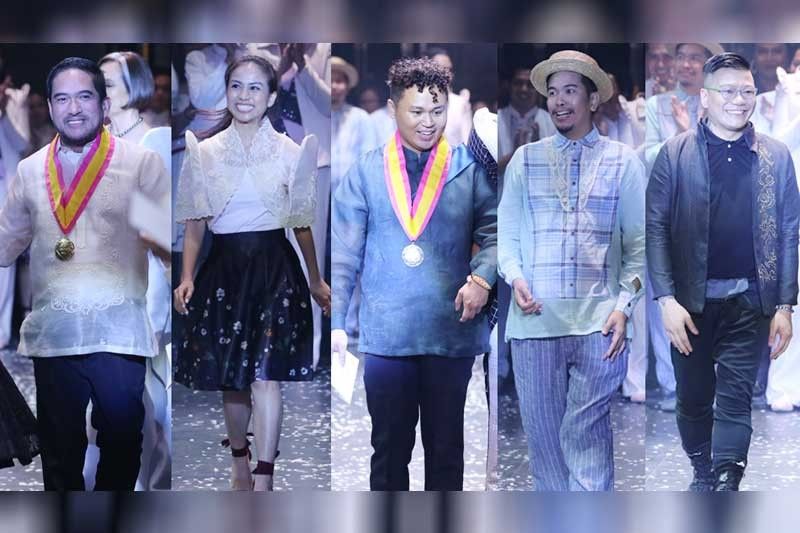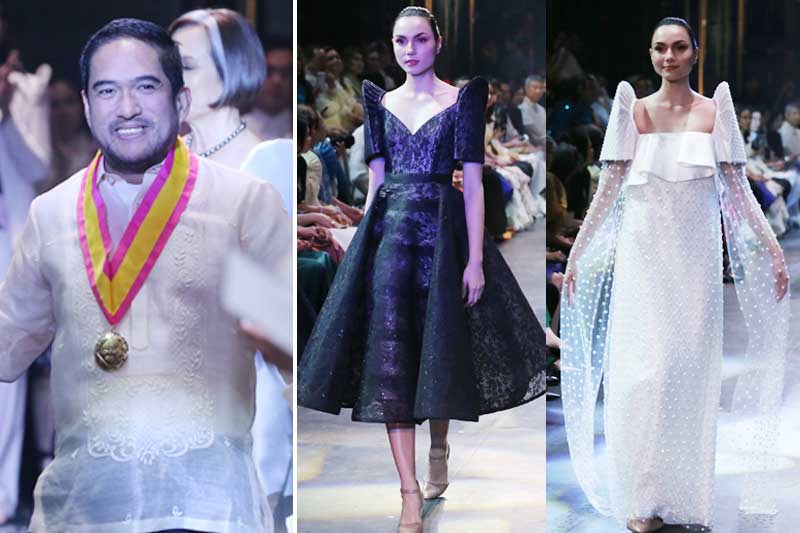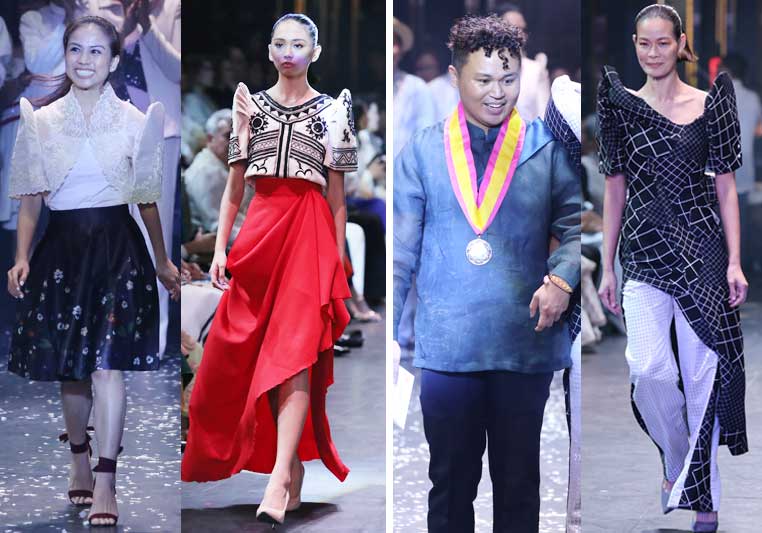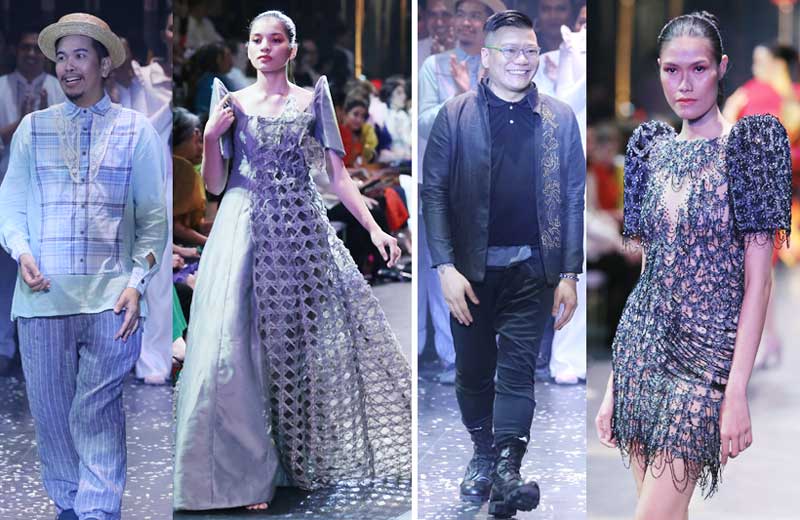What Makes A Winning Terno?


Terno-making convention and contest Ternocon 2018 culminated last night in a magical fashion and cultural show that will go down in history as the event that brought the terno back.
It was a triumphant collaboration between the Cultural Center of the Philippines’ Cultural Exchange Department and Bench/Suyen Corporation, as well as Ternocon artistic director Gino Gonzales, show director Dexter Santos, chief mentor Inno Sotto, Luzon mentor JC Buendia, Visayas mentor Cary Santiago, and Mindanao mentor Len Cabili, who showed terno collections alongside the 28 regional designers they mentored.
The 28 finalists were: Niyca Nava Alabanzas from Bacolod City, Marc Leo Aguilar from Vigan, Ilocos Sur; Dally Amandoron from Davao City; Rochelle Claire Baliong from General Santos City; Christon Soto Bautista from General Santos City; Michael Joseph Bawar from Sta. Maria, Bulacan; Vincent E. Calicdan from Cagayan de Oro; Jofel Chua Cegayle from Escalante City, Negros Occidental; Jaylo Conanan from Quezon City; John David Datoy from GenSan; Dan Ryan Duran from Siaton, Negros Oriental; Steve J. Genzola from Silay City; Geomarie Hernandez from Sto. Tomas, Batangas; Brylie Hiponia from Bacolod City; Jasmine Ibones from La Paz, Iloilo; Basil Malicsi from Los Baños, Laguna; Jerom Marcos from Sarangani; Maria Nenita Morden from Villasis, Pangasinan; Glenda Daraug Nakila from La Paz, Iloilo; Santi Obcena from Quezon City; John Carlo Pagunaling from Marilao, Bulacan; Felizardo Parreño from GenSan; Frederick Policarpio from Angeles, Pampanga; Irmalyn Codilla Raquedan from Mandaluyong City; Marlon Tuazon from Angeles, Pampanga; Krizna Tan from GenSan; Stef Tirado from Cebu City; and Kate Marie Villarin from San Pedro, Laguna.
Each was asked to design one cocktail version of a Balintawak terno and one formal evening terno as entries to the competition.
The contest itself was held on the CCP Main Theater stage, which included cultural performances and dancers clad in the traje de mestiza and Maria Clara dress the terno evolved from.
Judges Ben Chan, Joey Samson, Myrza Sison, Nicanor Tiongson and Felice Sta. Maria deliberated and scored the entries earlier in the afternoon, based on adherence to tradition and competition guidelines (30 percent); craftsmanship/execution of design (30 percent); creativity (30 percent); and wearability/functionality (10 percent).
“The judging process took about 4.5 hours,” said Sison. After a short briefing about the competition, its history, the screening and mentoring process, the other judges and I got to see all the ternos in the flesh during the dress rehearsal, after which we met, discussed the garments, and finalized our scores based on the criteria above, with the guidance of SGV.”
Fashion designer Joey Samson, an exponent of the terno who popularized his signature cage butterfly sleeve, said, “All aspects of design considered, a good number showed a lot of promise. I love how some of them also were able to inject ‘fun,’ interesting elements but in a constrained manner. Because most of the younger generation feels and looks at terno to be a costume, it is important to present it in a more relatable form, color, fabrication and design in general.”
Gold, silver and bronze medals were awarded for each category: cocktail Balintawak and formal evening terno. The big surprise of the night was when one designer, Marlon Tuazon from Angeles, Pampanga, won gold medals in both categories.
“After we submitted our score sheets, we compared notes about our favorites for each category, and both of Marlon’s entries were on all our lists of standouts,” Sison said. “We didn’t know he would win in both categories because the final tabulations were not revealed to us, not until the announcement at the end of the show.”
According to Myrza, all the judges loved Tuazon’s work. “Both of his winning ternos reflected his fresh aesthetic and distinctive point of view: surprising, clever, feminine yet strong, elegant and sophisticated. Their overall looks straddle the line between traditional and modern and are definitely bound to be timeless. And most of all, they are wearable and well made.”
* * *

GOLD MEDALS IN BALINTAWAK TERNO & FORMAL EVENING TERNO: MARLON TUAZON from Angeles, Pampanga
What was the inspiration for your ternos?
Ever since I was a kid I loved pearls, so every time I stepped out, I wanted my mother to have a pearl. So when I was finally able to work, I bought many pearls, and that was the inspiration for my gown.
What was the best advice your mentor, JC Buendia, gave you?
Many, many, many things. He taught me how to work harder, and to make things possible.
* * *
SILVER MEDAL IN FORMAL EVENING TERNO: MARIA NENITA MORDEN from Villasis, Pangasinan
What was the inspiration for your terno?
I was inspired by the Boxer Codex with the pintados, the tattoo ink from the Visayan region, and this is their tattoo. Actually it’s all hand-beaded and embroidered. It took about three weeks to finish, but I kept stopping because I have a two-year-old baby I have to take care of. But it was all worth it.
What was the best advice your mentor, JC Buendia, gave you?

Just do whatever you like. If your idea’s there, that’s it.
* * *
SILVER MEDAL IN BALINTAWAK TERNO: DAN RYAN DURAN from Siaton, Negros Oriental
What was the inspiration for your terno?
I was comparing Thailand and Philippines, and Thailand wasn’t colonized. When I went there, the inspiration for their Westernized clothing was their queen having couture made, and people saw it and became western, so I was translating it to my garments, especially the Balintawak. It’s supposed to be inspired by Madeline Vionnet. It’s one cut — the entire fabric is connected together, except for the sleeves.
What was the best advice your mentors Inno Sotto and Cary Santiago gave you?
Don’t overthink. I tend to think too much about my clothes, but once I get going, it’s free flowing.
* * *
BRONZE MEDAL IN FORMAL EVENING TERNO: MICHAEL JOSEPH BAWAR from Santa Maria, Bulacan
What was the inspiration for your terno?
Basically I was inspired by a barrio lass off to a ball, so I used the key elements of country life, like I envisioned a young lady inspired by the old china collection of her grandma, as well as local handicrafts, which I incorporated in my design.
What was the best advice your mentor, JC Buendia, gave you?

A lot, but one of the lessons that stuck to me was that you should never stop learning. You should push yourself with the boundaries of your creative vision.
* * *
BRONZE MEDAL IN BALINTAWAK TERNO: SANTI OBCENA from Quezon City
What was the inspiration for your terno?
My Balintawak terno was inspired by bakunawa, a dragon that swallowed the moon in Philippine folklore. The women in my studio and I took around a month and a half to finish the beading. I found vintage cotton lace on a side street, dyed it gray and we added all the embellishments so that when the light hits it, it looks like a dragon rising from the sea. Cary (Santiago) also helped a lot with the treatment and how I was able to do it, and Sir JC was very good at streamlining everything.
What was the best advice they gave you?
Go crazy. You can never go wrong with crazy.



















